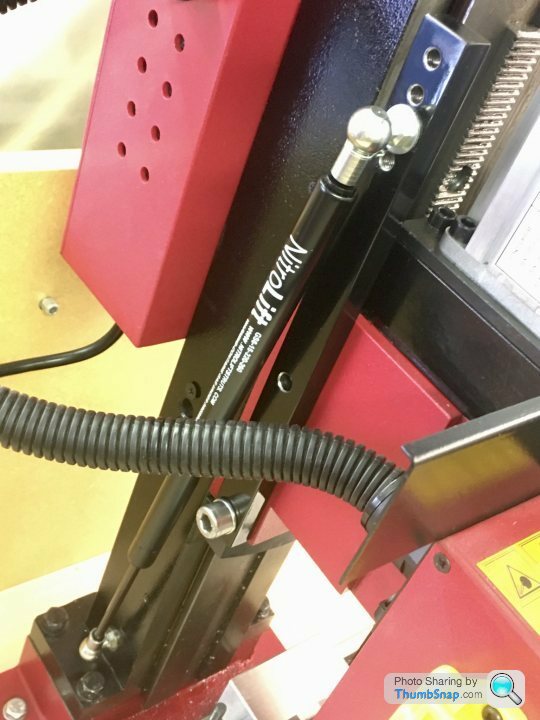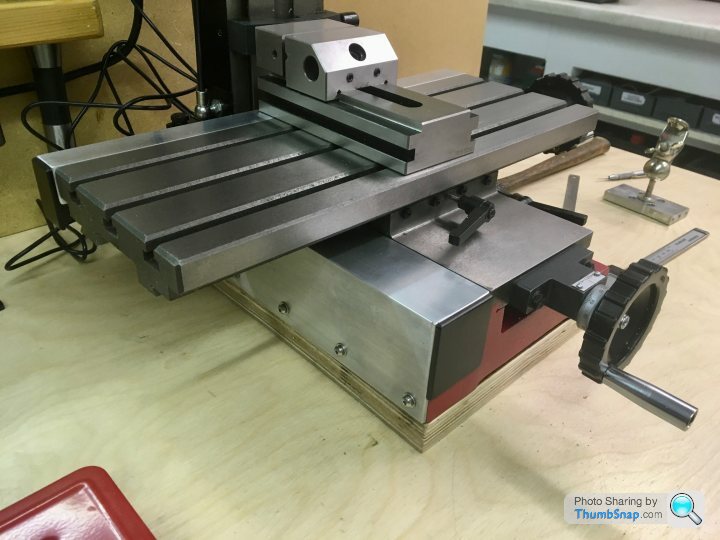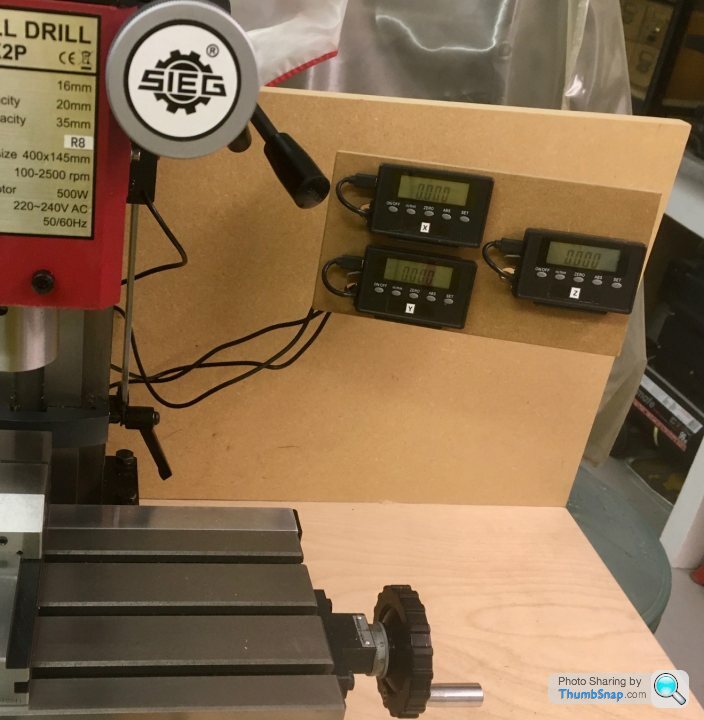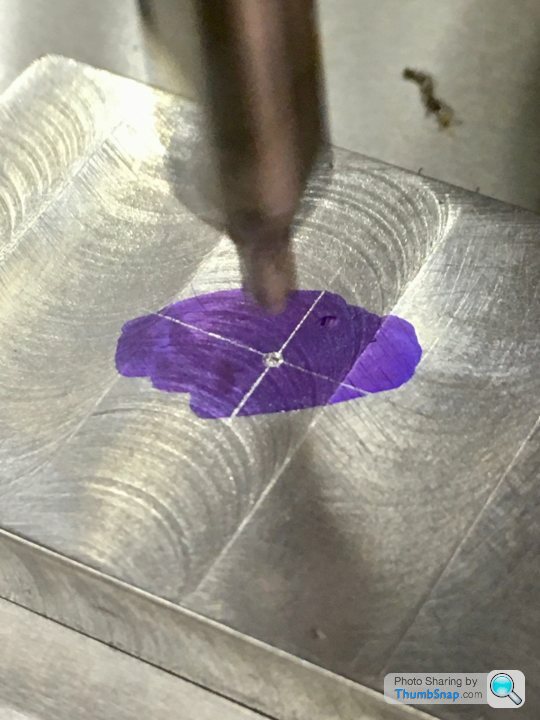Member postings for Dr_GMJN
Here is a list of all the postings Dr_GMJN has made in our forums. Click on a thread name to jump to the thread.
| Thread: Setting up a Mini Mill & Stuart 10V Machining |
| 07/05/2020 16:51:56 |
Thanks very much Andrew. I fully appreciate that making parts is more relevant than messing about chasing an impossible setup. However, my lack of experience means that I want to at least start with a setup that's in the right ballpark. I'm trying to determine where I am with that by initially making small parts for the mill, like the gas-strut mount, and the vice clamps, and doing some simple test pieces. Believe me I want to start on some real work asap. The cutter was an HSS slot drill. When you say machining marks caused by a defective tool - do you mean the swirls, or the ridges, or both? It wasn't rubbing - definitely cutting. Any advice on rpm for this diameter and depth of cut? I did indeed end up with a sticky mess of oily swarf which I'm still cleaning up... I marked out the centre of the work because I have to admit I've never really done it before, and wanted to check that a) my marking out method was accurate, and b) that I could use the edge finder and DROs properly. I hope that I haven't made two random errors that happened to coincide in one point!
|
| 07/05/2020 14:12:19 |
Hello all, this is my first post here – and I know it’s long, but I want to include as much relevant info as I can, so go easy!
Last year I bought a Stuart10V castings set from the Doncaster show, and want to make a start on it. I promised myself I’d start machining (even just the base) within a year of purchase – that deadline expires on Sunday, but there are some issues…can anyone help me achieve my goal? A bit of background – I have owned a Myford ML7 for about 12 years, I restored it after I bought it. I have done some basic bits and pieces on it, and some milling, but nothing really challenging at all. I bought an SX2P Mini Mill last September, specifically for building the engine, and have only just got around to setting it up. I’ve added X,Y & Z DROs, a gas strut and adjusted the tramming and gibs as best I can. I’ve read several books on model engineering, and building the 10V, and watched numerous video series on youtube. I found Andrew Whale’s channel very good and he has given some great advice off-line.    Anyway, I’ve just machined some test pieces on the mill, and this is where the questions start… 1) I couldn’t adjust the gibs properly with the slides assembled, so I removed the leadscrews, locked one axis and adjusted the other. I tested with a DTI by rocking the appropriate slide. I got about 0.001” of play and couldn’t get it any better. I found that an Allen key was useless for this task – too springy, so I used an Allen bit. I also found that the difference between movement and locked was significantly less than 1/8 turn of the grub screws. Question: I know I should aim for zero movement, but what is acceptable in reality? 2) I trammed the bed by mounting a DTI with its holder post in a collet, zeroing on a point on the bed, and turning it to the other 90 degree points over the width of the bed, and over the the equivalent length side-to-side. The diameter of the circle where the quadrant points were checked is around 130mm. The collet chuck was about 250mm above the bed. By shimming with steel, after a long, long time, I got each point to be within 0.001” of the zero datum point. I noticed that the needle moves beyond this limit if I pull on the column (not surprising I guess), but this will probably be representitive of cutting loads. Question: I know I should aim for zero on all points, but what is acceptable in reality? 3) I started by milling some vice clamps out of steel. I found the DROs worked great in conjunction with a Starrett edge finder. Overall, for a first attempt I was very happy with the dimensions achieved. However, I noticed a series of lines in the milled surfaces of the block, which could be felt running a finger over the surface. These aren’t machining swirls. Polishing with a buffing wheel improved matters, but this is obviously not the answer from an engineering viewpoint. I assumed it was poor tramming, so I re-trammed (to get to the aforementioned 0.001” figure), and milled (conventional) a test piece. This was exactly the same. I then dressed the edges with a file, turned the block upside down, and repeated the process. Same again. I then measured the thickness of the block in 9 places. I was getting about 0.002” thickness difference. The block is about 60mm x 40mm x 16mm thick. I was taking about 0.5mm deep cuts with a 10mm diameter 2 flute slot drill (it’s all I have at the moment, but I’ve got some 4 flute end mills on order). I was using cutting oil on the surface as a lubricant. Speed was about 1500 – 2000 rpm. Feed rate “steady”. There was some noise and minor vibration. I also tried milling a piece of aluminium, and the effect is there but much less obvious. Question: What can I do to get rid of ridging and dimensional error? 4) General questions: For my Stuart 10V, if I leave my mill as it is now with it’s current issues (if they are issues with this type of machine), will I be able to make my 10V to a good standard? In other words, it’s fine to want a perfect machine tool, but more relevant to me at present is “what accuracy do I need – am I chasing someting that’s not achievable with a Chinese machine tool”? I’ve included some images below (I hope they will show up). Thanks very much in advance!    Reply to Topic |
Want the latest issue of Model Engineer or Model Engineers' Workshop? Use our magazine locator links to find your nearest stockist!
Sign up to our newsletter and get a free digital issue.
You can unsubscribe at anytime. View our privacy policy at www.mortons.co.uk/privacy
- *Oct 2023: FORUM MIGRATION TIMELINE*
05/10/2023 07:57:11 - Making ER11 collet chuck
05/10/2023 07:56:24 - What did you do today? 2023
05/10/2023 07:25:01 - Orrery
05/10/2023 06:00:41 - Wera hand-tools
05/10/2023 05:47:07 - New member
05/10/2023 04:40:11 - Problems with external pot on at1 vfd
05/10/2023 00:06:32 - Drain plug
04/10/2023 23:36:17 - digi phase converter for 10 machines.....
04/10/2023 23:13:48 - Winter Storage Of Locomotives
04/10/2023 21:02:11 - More Latest Posts...
- View All Topics
- Reeves** - Rebuilt Royal Scot by Martin Evans
by John Broughton
£300.00 - BRITANNIA 5" GAUGE James Perrier
by Jon Seabright 1
£2,500.00 - Drill Grinder - for restoration
by Nigel Graham 2
£0.00 - WARCO WM18 MILLING MACHINE
by Alex Chudley
£1,200.00 - MYFORD SUPER 7 LATHE
by Alex Chudley
£2,000.00 - More "For Sale" Ads...
- D1-3 backplate
by Michael Horley
Price Not Specified - fixed steady for a Colchester bantam mark1 800
by George Jervis
Price Not Specified - lbsc pansy
by JACK SIDEBOTHAM
Price Not Specified - Pratt Burnerd multifit chuck key.
by Tim Riome
Price Not Specified - BANDSAW BLADE WELDER
by HUGH
Price Not Specified - More "Wanted" Ads...
Do you want to contact the Model Engineer and Model Engineers' Workshop team?
You can contact us by phone, mail or email about the magazines including becoming a contributor, submitting reader's letters or making queries about articles. You can also get in touch about this website, advertising or other general issues.
Click THIS LINK for full contact details.
For subscription issues please see THIS LINK.
Model Engineer Magazine
- Percival Marshall
- M.E. History
- LittleLEC
- M.E. Clock
ME Workshop
- An Adcock
- & Shipley
- Horizontal
- Mill
Subscribe Now
- Great savings
- Delivered to your door
Pre-order your copy!
- Delivered to your doorstep!
- Free UK delivery!









 Register
Register Log-in
Log-in


